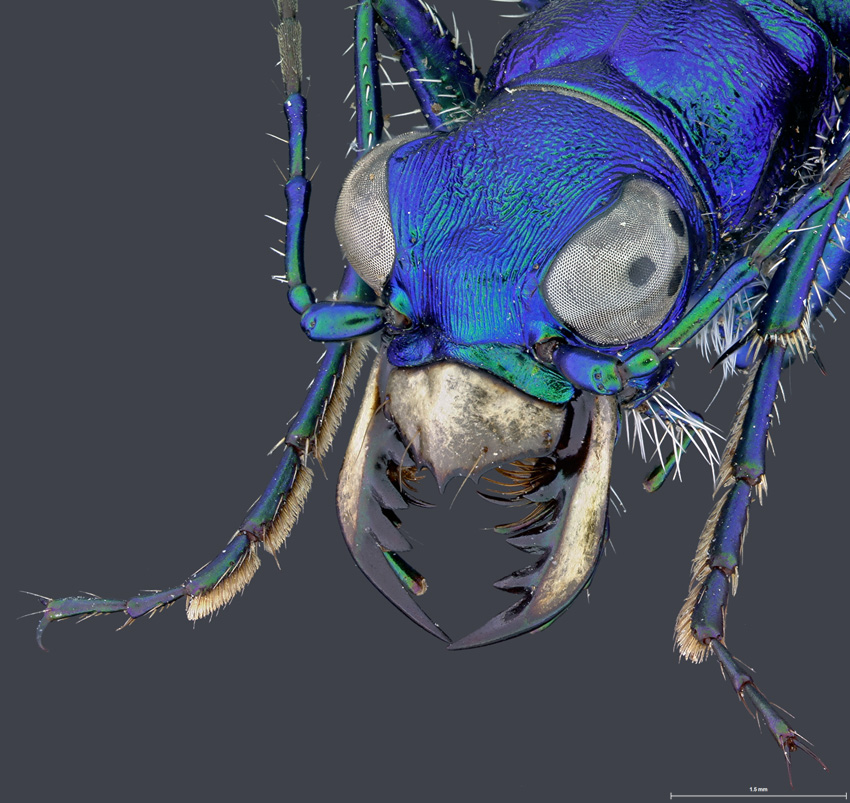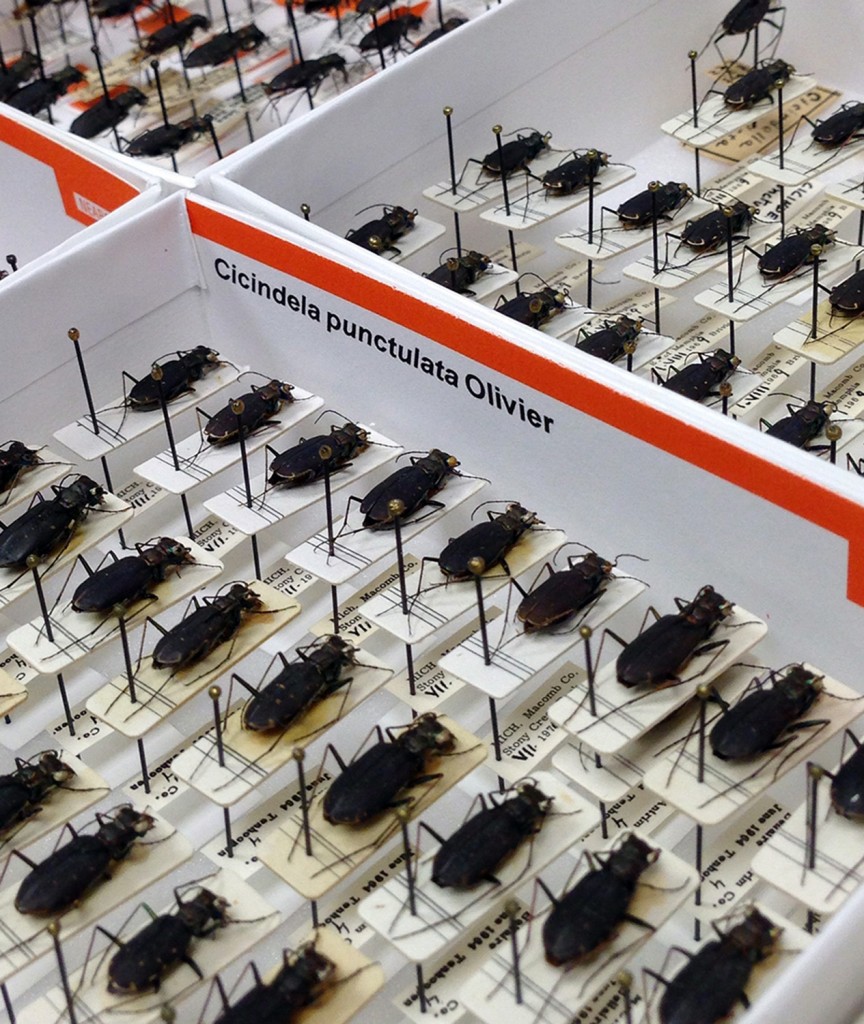
Specimen of six-spotted tiger beetle (Cicindela sexguttata F.), one of the species of ground beetles recently re-curated.
The Triplehorn Insect Collection is one of the largest university collections in the USA, holding about 4 million dry, mounted insect specimens, with many thousands more being added each year. The collection grew from the research collections of Ohio State faculty, curators, and students, dating back to the late 1890’s, when the university’s first entomologist, Herbert Osborn, was hired. Our specimens are used for research purposes by scientists from the USA and abroad.
Because of the age and the history of the collection, we have a very significant curatorial issue: an abundance of 70+ year old storage units, including the drawers and the trays that still hold most of our specimens today. These drawers and unit trays were the standard way back when, but are now considered, for various reasons, to be unsuitable for the long-term preservation of our specimens. The drawers, too shallow and with loose-fitting lids, and the unit trays, in various odd sizes, made of paper and lined with cork or wood, need to be replaced with standardized, museum quality materials.

Changes in costs and materials available over the years resulted in the use of a wide variety of now substandard materials. Notice the uneven size and shape of unit trays. Specimens are tightly packed due to earlier space restrictions.

Cork bottom unit trays such as this make it very difficult for staff and visiting scientists to handle specimens. Hard bottom does not fit properly, leaving large gaps around the edges of the unit tray.
Over the years, many of the insect pins have corroded and become solidly “trapped” in the cork pinning bottom. To add insult to injury, due to the chronic lack of storage space that affected the collection for most of our history, the old unit trays are ultra overpacked with specimens. That storage situation makes the handling the specimens for study and curation a very time-consuming, damage-prone operation.
In 2009 we secured a $415K collection improvement grant from the National Science Foundation to install a compactor storage system in the collection, develop a primary type database, and to make progress on rehousing specimens in new drawers and unit trays.
Since then a lot of curatorial work has been happening here. The re-curation process (i.e., moving the specimens & upgrading the curatorial status) involves four major steps, each deserving of a separate post, but here they are in a nutshell: 1) updating the taxonomic names associated with the specimens; 2) transferring specimens to new unit trays; 3) reorganizing and storing specimen unit trays in new, tightly closed, naphthalene-free drawers; and finally 4) databasing the specimen information.
We started the re-curation by diving head-first into the beetles (order Coleoptera), the most extensive, well-studied, and heavily used group of insects in our collection. The beetles, all 65 cabinets, 1600+ drawers of them (almost 20% of our collection!), are a massive curatorial challenge for our small and young staff. But what we don’t have in numbers and experience, we make up in care, enthusiasm & dedication.
Replacing the old unit trays is by far the most difficult part of the process. It involves gently, but firmly extracting each of the specimens from the old unit trays and transferring them to new, foam-lined trays. The process requires skill, patience, but most of all, discipline to resist the (sometimes almost overwhelming) urge to simply yank the specimens out of the old unit. Brute force, though tempting at times, is a big no-no in curation, and can only bring (curatorial) grief & (specimen) destruction: picture insect body parts, pins, and even bits of cork, flying across the laboratory – a complete curator’s nightmare. So, rule #1, no brute force. In the cases when the specimens are completely stuck, we use insect pliers (much like dentist’s pliers) to break the grip of the cork on the pin.

Insect pliers are used to gently pry specimens off the hard bottom unit trays without causing damage.
Once freed, the specimens are placed in new, acid-free, foam lined unit trays. The foam works much like a bug “pin cushion“, allowing for easy handling of the specimens in and out of the unit tray. The unit trays with the specimens are subsequently stored in new, tightly-sealed insect drawers.
Unit trays and drawers are carefully labeled according to the most updated taxonomic information for maximum accuracy and organization. To fulfill our commitment of making specimen level information freely available online, we transcribe and add the specimen information to our database. (More on databasing on a subsequent post).
So far 39,388 beetle specimens in 1,696 taxa, including all the ground beetles (family Carabidae), have been transferred to new storage units and drawers. Of those, 21,476 specimens (a whopping 55% of the total) have already been barcoded, databased, and are available online for your perusal. The others are still being worked on.
The bulk of this unnervingly tedious, extremely delicate, outrageously detailed, AND dramatically important piece of curatorial history at the Triplehorn Insect Collection is being executed by a team of carefully trained, skilled undergraduate curatorial assistants working under the supervision of the collection’s permanent staff.
Many interesting problems and issues have arisen during the re-curation process, some known to us, and some completely unexpected. We’ll be talking more about curatorial issues in subsequent posts.
In order to evaluate the efficiency and to quantify the costs of the re-curation process, we have been keeping detailed records of all our activities. We presented a preliminary report of our work at the 2012 Annual Meetings of the Entomological Society of America in the form of a poster. (PDF copy here)
References:
L. Musetti, S.E. Hemly and N.F. Johnson. “Quantification of the costs of insect collection curation.” Poster Presentation. Annual Meeting of the Entomological Society of America. 13 November, 2012. Knoxville, TN.
About the Author: Dr. Luciana Musetti is an Entomologist and Curator of the Triplehorn Insect Collection.


